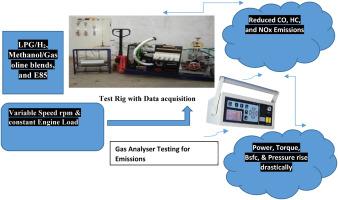One-dimensional computational investigations on a 3- cylinder spark ignition engine fuelled LPG/H2, methanol/gasoline blends, and E85 for meeting future emission norms
IF 3.4
Q2 ENVIRONMENTAL SCIENCES
引用次数: 0
Abstract
This study explores a new strategy for enhancing performance and lowering emissions in a three-cylinder spark ignition engine by utilizing various blended alternative fuels. Using one-dimensional simulation software. Avl Boost analysed the engine's emission characteristics and performance metrics across a speed range of 1500–5000 rpm. The optimal fuel blend 80 % LPG and 20 % hydrogen delivered impressive results. It boosted Brake power by 30 % compared to M10/G90 and by 20 % over E85/G15 while also improving thermal efficiency by 25 %. A comparative analysis of three fuel blends (mixed by volume) showed performance gains across all options. Both M10/G90 and E85/G15 blends exhibited better power output. Brake-specific fuel consumption, and Brake mean effective pressure notably, the E85/G15 blend produced 15 % more brake power than M10/G90 and achieved a 10 % reduction in Bsfc. The LPG80/H220 blend stood out for its efficiency, registering the lowest Bsfc values 45 % and 50 % lower than ethanol and methanol blends, respectively. Emission modelling further confirmed its advantages, as it resulted in the lowest CO, HC, and NOx emissions. However, a slight rise in NOx emissions was observed at higher engine speeds.

为满足未来排放标准,对以LPG/H2、甲醇/汽油混合物和E85为燃料的3缸火花点火发动机进行了一维计算研究
本研究探索了一种利用各种混合替代燃料来提高三缸火花点火发动机性能和降低排放的新策略。采用一维仿真软件。Avl Boost分析了发动机在1500-5000 rpm转速范围内的排放特性和性能指标。80%液化石油气和20%氢气的最佳混合燃料产生了令人印象深刻的结果。与M10/G90相比,它将制动功率提高了30%,比E85/G15提高了20%,同时还将热效率提高了25%。三种燃料混合物(按体积混合)的比较分析显示,所有选项的性能都有所提高。M10/G90和E85/G15均表现出较好的输出功率。尤其值得注意的是,E85/G15混合动力车产生的制动功率比M10/G90多15%,Bsfc降低了10%。LPG80/H220混合物在效率方面表现突出,其最低Bsfc值分别比乙醇和甲醇混合物低45%和50%。排放模型进一步证实了它的优势,因为它能产生最低的CO、HC和NOx排放。然而,在较高的发动机转速下,观察到氮氧化物排放量略有上升。
本文章由计算机程序翻译,如有差异,请以英文原文为准。
求助全文
约1分钟内获得全文
求助全文
来源期刊

Atmospheric Environment: X
Environmental Science-Environmental Science (all)
CiteScore
8.00
自引率
0.00%
发文量
47
审稿时长
12 weeks
 求助内容:
求助内容: 应助结果提醒方式:
应助结果提醒方式:


